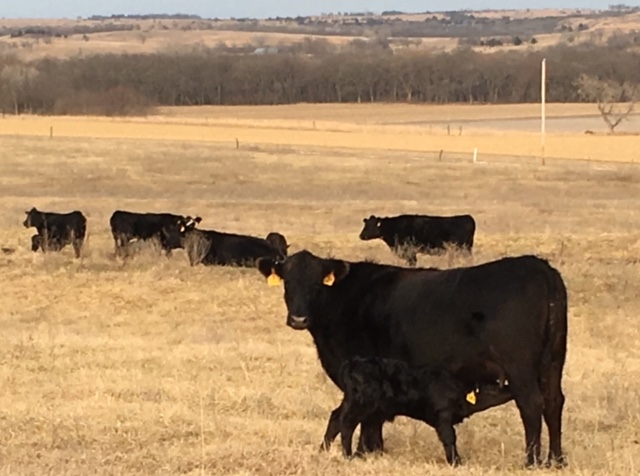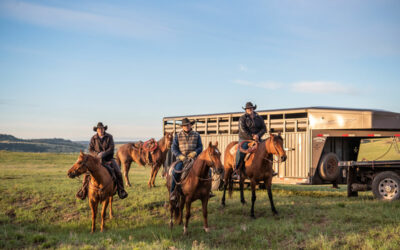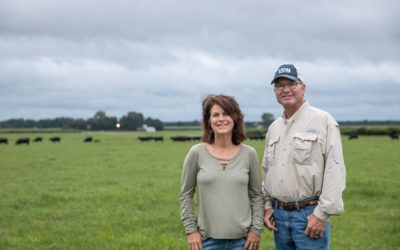
It’s all good
I love calving season each year, but this one will be hard to beat. I used to do this in the winter on my northeast Kansas farm, starting in February. With heifers due on pasture leases the first of May, we couldn’t wait too long for synchronized artificial insemination (AI) early that month.
There’s been no change in breeding date over the last 20 years, but winter here has retreated. This year, the short month was so mild we didn’t exaggerate to call it spring calving. As one result, we calved the first quarter of our herd a month before the first day of spring with no losses till this morning. We went to 39/40 when a bull calf came backwards to a mature cow and unfortunately inhaled fluids; the streak had to end, but so far the weather is holding.
Our calves should be the healthiest ever. Each has been up and nursing within minutes, getting a full dose of immunizing colostrum and then dozing in comfort.

I have to think back 36 years to my first calving season here with a couple dozen registered Continental cows. Winter was an obvious challenge in February and March, and even mature cows could have problems.
We watched them all, helping when necessary and couldn’t wait to see each new calf as soon as possible. Did I want “a boy or a girl?” It didn’t matter then because one could become a sale bull and the other could build the herd.
I didn’t know how much culling and “wholesale herd changing” lay ahead, mostly in search of calving ease and lower-input cows. As the cattle cycle turned and the family grew, we were running a random-quality, mostly black herd. I wanted male calves because steers weighed more and brought more money per pound.
With the start of AI in this commercial herd – first heifers and then the better half of cows 15 years ago – I always felt more elation from early-born heifers than bulls that would become steers on day one. I learned from the steers though, as their gain and carcass data came back to sire groups, cows and keep-or-cull decisions.
The whole idea behind AI was faster genetic improvement, so heifer calves were the most welcome. There were exceptions of course. Some bred heifers were kept only to see if a very docile sire could tame some of the too-hot maternal fire in otherwise productive cow families.

Sometimes it worked, and sometimes it didn’t. After all this time, we are finally ending those trials and no longer giving the chance to scions of questionable disposition lines.
It’s a good feeling to get disposition more nearly under control.
There are still a few proddy old cows, some that could win an Oscar for attempted assault, but given a decade of chances, they have always stopped short of trying to hurt anyone tagging their calves. There are a few that grow suspicious as they get old and become too smart to fall for the traps management requires. If they have to be escorted in as singles, they’ll have to leave the farm.
For the most part, when docility is even and adequate, I can be just as happy to have a steer for the feedlot and premium beef production as to raise a potential replacement heifer backed by the decades of focus and culling toward an ideal.
Since calf sex is still random here, that brings peace of mind.
Let’s keep building tomorrow together!
Steve
You may also like
Everything They Have
Progress is a necessity on the Guide Rock, Nebraska, ranch where Troy Anderson manages a commercial Angus herd, small grower yard, his 10-year-old son, and a testing environment. Troy’s approach includes respect for his livestock, people and land. For that, Anderson Cattle was honored with the CAB 2023 Commercial Commitment to Excellence Award.
The Competitive Drive
The Bootheel 7 brand that marks the hips of the Wasserburger’s cow herd could stand for the seven state wrestling titles held between three boys in the fourth generation, but that mark far predates their competitive drive. It’s been the brand carried by Wassserburgers looking for the ‘W’ since the homesteading era.
Targeting excellence
First-generation seedstock producers Kevin and Lydia Yon, along with their children, Drake, Sally, and Corbin, have been continuously improving their farm since they drove the first fence posts on what was a 100-acre abandoned peach orchard in 1996.



